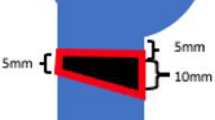Abstract
Introduction
The stem/keel location varies between anatomic and symmetric revision tibial baseplates. The current study investigates the impact of an anatomic versus symmetric stem location on the need for offset couplers in revision total knee arthroplasty.
Materials and methods
Hip to ankle standing radiographs and lateral radiographs of 75 patients were analyzed using digital templating software. The offset in the anterior–posterior as well as medial–lateral plane between the center of the tibial diaphysis and the stem of the tibial baseplate were determined for an anatomic and symmetric tibial baseplate, respectively. Measurements were repeated for 4 resection levels: tip of fibular head (0), 10 mm (1), 15 mm (2) and 20 mm (3) below the tip of the fibula head.
Results
Anatomic tibial baseplates require less offset for resection levels up to the tip of the fibula: total offset 2.28 versus 5.44 mm (p < 0.001). However, for defects that result in resection levels below the tip of the fibula symmetric tibial baseplates require less offset: resection level 1: 3.18 versus 2.4 mm (p = 0.008), 2: 4.81 versus 1.67 mm (p < 0.001) and resection level 3: 5.66 versus 1.52 mm (P < 0.001).
Conclusion
The current study suggests that while asymmetric anatomic tibial baseplates have benefits for revisions with minimal bone loss, symmetric tibial baseplates require less offset when larger bone defects are encountered.








Similar content being viewed by others
References
Graichen H (2014) TKA revision - reasons, challenges and solutions. J Orthop 11(1):1–4. doi:10.1016/j.jor.2014.01.005
Engh GA, Herzwurm PJ, Parks NL (1997) Treatment of major defects of bone with bulk allografts and stemmed components during total knee arthroplasty. J Bone Jt Surg Am 79(7):1030–1039
Christie MJ, DeBoer DK, McQueen DA, Cooke FW, Hahn DL (2003) Salvage procedures for failed total knee arthroplasty. J Jt Surg Am 85-A(Suppl 1):S58–S62
Cameron HU (1995) Clinical and radiologic effects of diaphyseal stem extension in noncemented total knee replacement. Can J Surg J Can De Chir 38(1):45–50
Brooks PJ, Walker PS, Scott RD (1984) Tibial component fixation in deficient tibial bone stock. Clin Orthop Relat Res 184:302–308
Bieger R, Huch K, Kocak S, Jung S, Reichel H, Kappe T (2014) The influence of joint line restoration on the results of revision total knee arthroplasty: comparison between distance and ratio-methods. Arch Orthop Trauma Surg 134(4):537–541. doi:10.1007/s00402-014-1953-4
Hvid I, Hansen SL (1985) Trabecular bone strength patterns at the proximal tibial epiphysis. J Orthop Res : 3(4):464–472. doi:10.1002/jor.1100030409
Hvid I, Hansen SL (1986) Subchondral bone strength in arthrosis: Cadaver studies of tibial condyles. Acta Orthop Scand 57 (1):47–51
Bourne RB, Finlay JB (1986) The influence of tibial component intramedullary stems and implant-cortex contact on the strain distribution of the proximal tibia following total knee arthroplasty: an in vitro study. Clin Orthop Relat Res 208:95–99
El-Zayat BF, Heyse TJ, Fanciullacci N, Labey L, Fuchs-Winkelmann S, Innocenti B (2016) Fixation techniques and stem dimensions in hinged total knee arthroplasty: a finite element study. Arch Orthop Trauma Surg 136(12):1741–1752. doi:10.1007/s00402-016-2571-0
Schlegel UJ, Bruckner T, Schneider M, Parsch D, Geiger F, Breusch SJ (2015) Surface or full cementation of the tibial component in total knee arthroplasty: a matched-pair analysis of mid- to long-term results. Arch Orthop Trauma Surg 135(5):703–708. doi:10.1007/s00402-015-2190-1
Tang Q, Zhou Y, Yang D, Xu H, Liu Q (2010) The offset of the tibial shaft from the tibial plateau in Chinese people. J Bone Joint Surg Am 92(10):1981–1987. doi:10.2106/JBJS.I.00969
Nagamine R, Miura H, Bravo CV, Urabe K, Matsuda S, Miyanishi K, Hirata G, Iwamoto Y (2000) Anatomic variations should be considered in total knee arthroplasty. J Orthop Sci 5(3):232–237. doi:10.1007/s007760000050232.776
Hicks CA, Noble P, Tullos H (1995) The anatomy of the tibial intramedullary canal. Clin Orthop Relat Res 321:111–116
Abraham R, Malkani AL, Lewis J, Beck D (2007) An anatomical study of tibial metaphyseal/diaphyseal mismatch during revision total knee arthroplasty. J Arthroplast 22:241–244. doi:10.1016/j.arth.2006.06.001
Yoo JH, Kang YG, Chang CB, Seong SC, Kim TK (2008) The relationship of the medially-offset stem of the tibial component to the medial tibial cortex in total knee replacements in Korean patients. J Bone Jt Surg Br 90(1):31–36. doi:10.1302/0301-620X.90B1.19605
Wevers HW, Simurda M, Griffin M, Tarrel J (1994) Improved fit by asymmetric tibial prosthesis for total knee arthroplasty. Med Eng Phys 16 (4):297–300
Westrich GH, Haas SB, Insall JN, Frachie A (1995) Resection specimen analysis of proximal tibial anatomy based on 100 total knee arthroplasty specimens. J Arthroplast 10(1):47–51
Yun X-D, An L-P, Jiang J, Wang C-F, Wang J, Ma J-L, Xia Y-Y (2015) The offset of the tibia plateau of osteoarthritis patients: a single-center study. Int J Clin Exp Med 8(9):16907–16913
Author information
Authors and Affiliations
Corresponding author
Ethics declarations
Conflict of interest
The senior author is a consultant with Smith & Nephew (Memphis, TN, USA). Dr. Boettner reports personal fees from Smith and Nephew, personal fees from Ortho Development Corporation and personal fees from DePuy, outside the submitted work.
Ethical approval
The study was approved by the institutional review board.
Rights and permissions
About this article
Cite this article
Foruria, X., Schmidt-Braekling, T., Nabarte, D.A. et al. Does the tibia component design affect the need for offset stems in revision total knee arthroplasty?. Arch Orthop Trauma Surg 137, 853–860 (2017). https://doi.org/10.1007/s00402-017-2677-z
Received:
Published:
Issue Date:
DOI: https://doi.org/10.1007/s00402-017-2677-z



